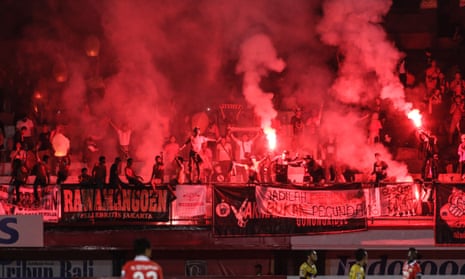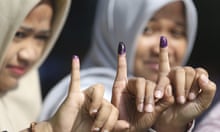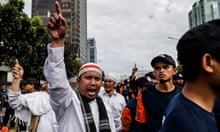Earlier this month, 16 buses full of hundreds of “Jakmania” – the nickname for fanatical supporters of Persija, Jakarta’s leading football club – were travelling in a convoy near the town of Palimanan in West Java.
With their trademark orange uniforms and flags, the fans (both official and unofficial members of Jakmania) had just finished cheering on their team against arch-rivals Persib Bandung – a club based in the city three hours from the Indonesian capital.
The match, which ended in an uncontroversial 0–0 draw, was supposed to have been held in Persija’s home ground, the majestic Gelora Bung Karno stadium in Central Jakarta. But a riot during Persija’s previous home match – which saw four policemen injured, including one who was left in a coma for several days – caused police to move it to a neutral venue more than 500 kilometres away, and to ban all Persib supporters, known as Vikings, from attending.
Relations between Jakmania and Vikings were particularly tense because a month earlier, several Jakmania had attacked some rival fans on the outskirts of Jakarta. A 17-year-old Persib supporter, Muhammad Rovi Arrahman, was beaten to death.
Despite the ban on Vikings’ attendance at last November’s game, trouble was again in the air. “We were told to be careful, because some Vikings had been spotted near Palimanan,” recalls Donal Aldiyansah, the acting chairman of Jakmania.
He ordered the bus convoy to stop at a rest area until police could sort out their security. When they finally continued their trip back to Jakarta, they were escorted by several policemen – but as the Jakmania buses approached a motorway toll gate, they were pelted with showers of stones. “It was the Vikings. We knew it from their blue shirts and scarfs,” Aldiyansah says.
While some buses tried to escape, others pulled over. Hundreds of Jakmania stormed out and ran towards their attackers, and an ugly brawl broke out at the side of the motorway. A few hours later, when the clash subsided, Persija fans found one of Jakmania’s regional coordinators, Harun Al Rasyid Lestaluhu, lying dead on the ground, his face and body badly beaten.
Jakarta’s ghetto
Indonesian football, which only recently had its ban lifted by Fifa following a murky dispute over who runs the game here, has a hooliganism problem. Save Our Soccer (SOS) – one of the Indonesian game’s few critical voices – was one of the first groups to highlight that football-related violence in this country has reached alarming levels.
Since the Indonesian Football League started in 1993-1994, at least 54 football-related deaths have occurred, according to SOS’s research. “These numbers cannot be underestimated or referred to just as accidents. It’s too expensive if watching football can cost someone’s life,” says an SOS coordinator, Akmal Marhali.

Pointing to the history of violence between Persija Jakarta and Persib Bandung, Marhali has several explanations for the spate of tragic incidents. “There is fanaticism in each camp, of course, and the sense of rivalry is high.” Indonesian fans are also highly influenced by European football culture, which itself continues to wrestle with the long-standing problem of hooliganism.
But Marhali also criticises the repeated lack of forward-planning from the security forces, and the absence of a proper supporter management programme from both the clubs and the Indonesian Football Association. “If every feud is not solved completely and clearly, similar incidents will continue to recur,” Marhali says.
In truth, however, the roots of Jakarta’s football hooliganism run much deeper, into the very makeup of Jakartan society. To better understand the violence surrounding Jakmania, we visit one of the supporters’ strongholds: the district of Manggarai in East Jakarta.
It is not hard to identify places where Jakmania fans like to hang out here. There are graffiti signs everywhere, such as the large Persija symbols on the walls near the train station. Among Jakmania, the Manggarai district is dubbed “Barrabravas”, because they often sparks riots in the soccer field. The term is taken from the name for hooligan groups in Latin America.
Manggarai is known as Jakarta’s ghetto: it is is one of the most densely populated areas in the city, and has the highest rate of unemployment. Riots and small-scale clashes – known in local slang as “tawuran” – occur here on a regular basis.
A couple of years ago, the police erected an iron fence in one part of Manggarai, to prevent young people from different areas brawling against each other. So the youths simply began throwing stones back and forth over the fenc, intifada-style. And they carry this attitude into the football arena too.
“This is a violent neighbourhood, with or without Jakmania,” says Herdian Lesmana, with a wry laugh.
Lesmana – better known by his nickname Uban (for his grey hair) – is a regional coordinator for Jakmania, based in Manggarai. He is in charge of organising meetings and preparing transport so the hundreds of fans who live here can attend each Persija match.
“We know many Persija fans are violent and often trigger unrest,” Uban says. He is, however, less forthcoming about the motives behind his group’s anger. “In every game, we always try to calm our base – but it’s hard.”

Of the tens of thousands of fans who regularly watch Persija play, only a fraction are registered as official members of Jakmania. The unofficial fans are known as “Rojali” (short for “Rombongan The Jak Liar”) because they never buy a ticket. To watch a match at Gelora Bung Karno Stadium costs a minimum of 50,000 rupiah – too expensive for many of the team’s supporters, for whom a meal in a modest food stall in Jakarta costs 15,000 rupiah.
The former chairman of Jakmania, Richard Achmad Supriyanto, admits it is almost impossible to control the behaviour of all these fanatic supporters, who are spread far and wide throughout Jakarta’s suburbs and beyond.
But Uban is also critical of the police for not helping him to control his fellow fans – both inside and outside the stadium. He claims police are often reckless and use excessive violence when they confront Jakmania: “They quickly use their batons or tear gas – but we are football fans, not terrorists. Using tear gas will provoke a riot.”
‘All hell broke loose’
The antipathy between Jakmania and the police peaked in May this year, after a 16-year-old fan, Muhammad Fahreza, was killed in the middle of a game between Persija and Persela Lamongan at the Gelora Bung Karno stadium. Fahreza had been stuck outside the stadium, among the masses who do not have tickets and try to push their way in.
“They don’t have tickets, so they will sing and make loud noises from outside the stadium and wait for ‘jebolan’,” explains Akbar (alias Bontot), a 22-year-old official coordinator for Jakmania.
The term jebolan refers to the moment during a match when police decide to open the stadium gates to spectators without tickets. Usually this access is given after half time, or when police can no longer hold the gate closed. At some point during the game in May, the stadium’s gates – heavily guarded by police – were opened.
After the match had finished, Fahreza’s brother Sholeh discovered him lying inside an ambulance, and decided to take him home. It is not known when Fahreza’s injuries had been sustained, but his condition deteriorated rapidly overnight, and the next day he was rushed to hospital – where he later died. According to Sholeh, his body was full of bruises, and there were swellings on the back of his head.

Sholeh claims his brother was beaten by the police – an accusation they denied, adding that the investigation was ongoing. According to a Jakarta police spokesman, Brigadier General Boy Rafly Amar, the only witness suggesting Fahreza had been beaten by police was Sholeh, who claimed he heard it from his brother before he died. “There is no other witness,” Boy said in August.
The death of Muhammad Fahreza angered many Jakmania. The following home game, against Sriwijaya FC, had to be abandoned when a skirmish happened in front of Persija’s goal and the opposing team scored. Jakmania were furious: firecrackers were lit in the stands and thrown on to the pitch. All hell broke loose when one supporter jumped over the fence on to the pitch, followed by hundreds more. The police fired tear gas and the match had to be stopped.
One police officer, Brigadier Hanafi, was separated from his ranks and immediately set upon by some fans, who beat him badly. Other Jakmania ransacked fences and stacked them on top of this policeman. At that critical moment, several officers approached and chased the attackers away, and Hanafi was rushed to the hospital. After being in a coma for several days, his condition improved – but he had lost the use of his left eye.
Cycle of violence
“All Cops Are Bastards”: this slogan was discovered in an old sketch book belonging to Fahreza after his death. Elsewhere in the book, Fahreza refers to himself as an “ultra”, a widely used term for hooligans in Europe.
Jakmania spokesperson Diky Soemarno says he is familiar with the acronym ACAB (also known by the code “1312”, after the position of the letters in the Roman alphabet). “Many of our members just follow the term because it had been a trend in the UK,” Soemarno says, adding that Jakmania leaders cannot easily stop it from circulating further. “It’s already a trend in social media among teenagers who are members of Jakmania.”
Shirts and accessories featuring ACAB can be found very easily in Jakarta. In a T-shirt shop selling a variety of Persija related merchandise in Kalimalang, East Jakarta, there is a stack of shirts with the slogan: “No one like us, we do not care. We are the real Persija fans.”
Jamaludin, alias Oboi, is the coordinator of Persija fans from Cikarang, an area full of factories on the outskirts of Jakarta. He is currently detained in the Jakarta police headquarters, having been charged for assaulting Brigadier Hanafi at the game against Sriwijaya in June.

Speaking from his cell in August – his hair shaved clean, and wearing an orange prisoner’s shirt – Oboi gives his version of events that day, claiming he was the fan who first jumped over the stadium fence and ran on to the pitch.
Oboi says it was the police who triggered the violence, when they fired tear gas into the crowd. “I jumped on to the pitch to avoid the tear gas; I had almost fainted. It was chaotic, and I jumped because I wanted to save my men.”
Oboi claims he didn’t beat up the police nor assault them in any way. But he refuses to comment on the reasons for Jakmania’s hatred towards the police, about ACAB or Fahreza’s death. He repeatedly denies any wrongdoing in the incident.
Another Jackmania fan, Nicko Primary Suhendar, 20, who was inside the stadium during the riot but is not implicated in the Hanafi incident, admits the fans did set off firecrackers when Persija’s goalkeeper conceded a goal in the 80th minute.
“There was a lot of noise, but then the police fired tear gas at us,” Suhendar says, suggesting the police had provoked Jakmania to respond violently. Then he adds: “We still hold a grudge against the police because of Fahreza’s death.”
The deputy director of the Jakarta police’s Violent Crime Unit, Grand Commissioner Adjutant F Hendy Kurniawan, says he has heard of the hatred for the police among Jakmania fans – but adds that the police have not yet fully assessed this sentiment. “We haven’t seriously looked into it,” he admits.
His comment seems to offer little hope for Indonesian’s violent, divided football culture. However, when asked if there is any way out of this cycle of violence, Marhali from SOS points to a past initiative which sucessfully reconciled “Bonek” (supporters of Persebaya Surabaya) with Pasoepati (supporters of Persis Solo).
“These fans used to clash regularly,” Marhali says. “But now, after several years and a bunch of reconciliation efforts, both clubs never find their fans attacking each other again.” The question is, can the same now be done for Jakmania’s hooligan element?
This piece was produced in collaboration with Tempo, Indonesia’s leading source for investigative journalism
Follow Guardian Cities on Twitter and Facebook and join in the discussion










Comments (…)
Sign in or create your Guardian account to join the discussion